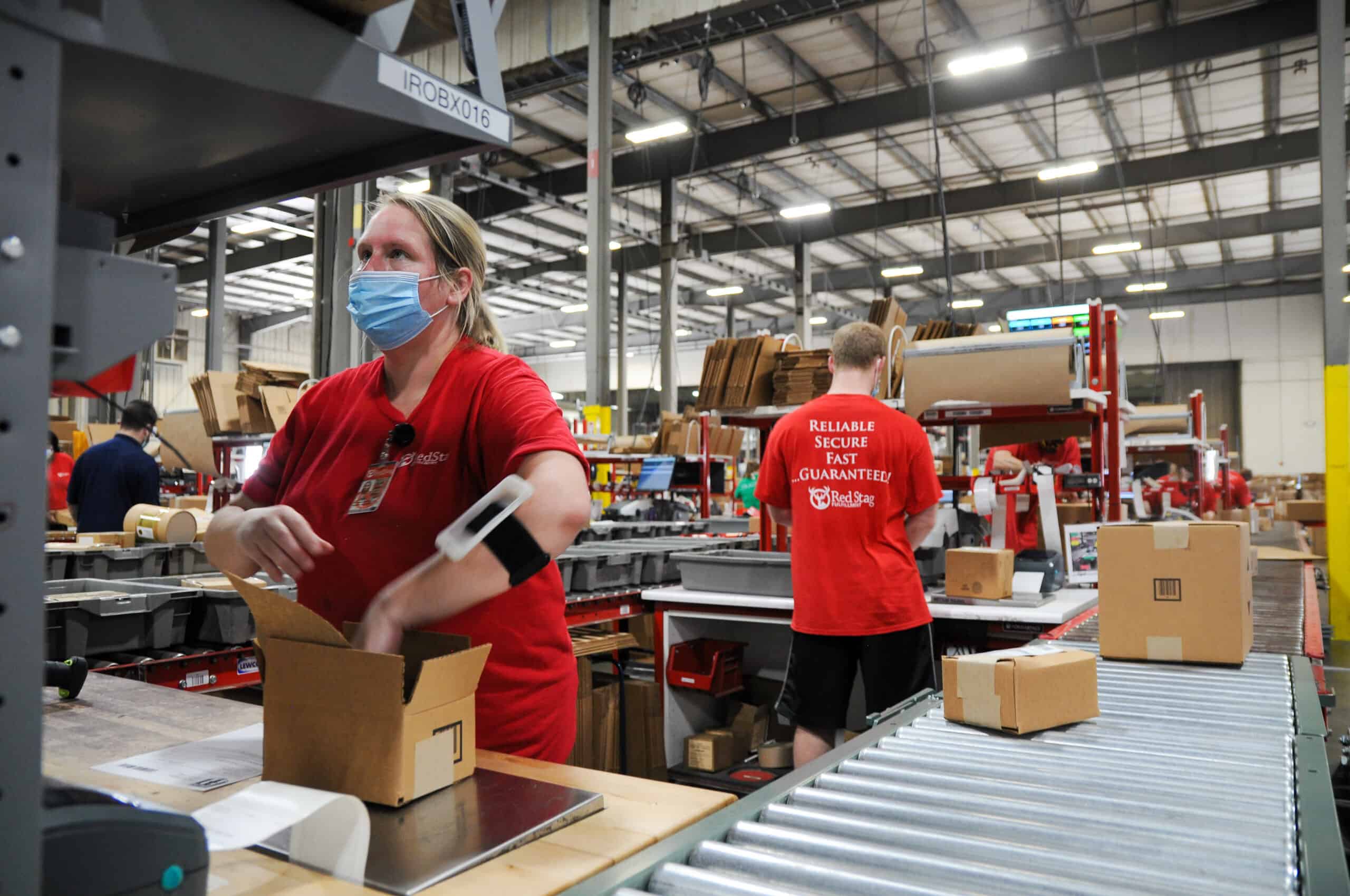Retail businesses are always looking for ways to boost sales and customer satisfaction. An omnichannel order management system can help you do both—and much more.
Learn how an omnichannel order management system can enhance the way you do business, from streamlining inventory management to increasing customer loyalty.
We’ll cover the following topics:
- What is order management?
- What is omnichannel order management?
- How an omnichannel management system benefits customers
- Order management benefits for ecommerce businesses
- How to get started with omnichannel order management
What is order management?
Order management is the process of managing and tracking every step of an order’s journey, from creation and fulfillment to delivery. It covers capturing an order on a given sales channel, tracking that order’s details, having your team pick and pack it, and then final delivery.

Order management has moved from primarily over the phone and on paper to complex software. Order management systems (OMS) can now track inventory, match available inventory to orders, and help your team accurately ship products to customers.
The goal of your team and the OMS is to get orders to people accurately and on time, while minimizing or eliminating the risk of running out of stock for future orders. It’s part of your broader order logistics efforts.
This is an essential part of ecommerce. Red Stag Fulfillment believes that on-time processing and accurate orders are such a core part of your offering that we provide our partners with order fulfillment guarantees.
What is omnichannel order management?
Omnichannel order management is a system that businesses use to manage and fulfill customer orders across all their sales channels, including online, in-store, and phone.
By using a robust omnichannel order management system, you can combine orders from every sales channel into one list. This will make it easier for you to fill orders and track inventory.
The software and scanners will count everything for you instead of requiring a team to track each order history by channel and continually communicate with inventory teams to obtain an accurate count.
For small and growing ecommerce businesses, manually doing this work can take too many people away from picking and packing orders, slowing down efforts. As you grow, it can actually get even harder to do this manually. This is because you’re typically working across multiple locations with more inventory and SKUs.

Instead of needing large teams at every location to communicate order status back to centralized buyers, an omnichannel order management system can bring all orders together into a single stream and check inventory levels against that unified list.
As you grow, handling order management and fulfillment tasks individually could become a job that takes a full workday—every day. Inventory management software can automate this for you. This means you get the omnichannel order management look without having to live in spreadsheets.
Omnichannel order management example
Let’s see what omnichannel order management looks like in action.
Say you received multiple orders overnight from your website, Facebook Shop, and physical store. Instead of logging into different systems to view each set of orders separately, you can view them all in one place.
You start processing the orders. A customer from your website has requested express shipping, while another customer from your Facebook Shop has opted for in-store pickup. With omnichannel order management, you can easily assign the appropriate shipping method to each order without having to switch between systems.
Now, you notice a popular item is selling out fast. Thanks to real-time inventory visibility across all channels, you can quickly update the product availability to prevent overselling. This ensures customers have a smooth shopping experience, whether they’re online or in-store.
Later in the afternoon, a customer asks to return an item. With an omnichannel order management system, you can process the return seamlessly, regardless of where the order was placed. This helps you meet customer expectations and boost satisfaction while streamlining your internal processes.
By the end of the day, you successfully managed orders from multiple sales channels without any hiccups. You improved efficiency, reduced errors, and provided a seamless customer experience across all touchpoints.
Why does this matter to your store?
Omnichannel order management speeds up your store’s ability to track and use its inventory. This has various benefits, including cost savings and better product use. You’ll also have the latest inventory data to make the best possible decisions.
Thankfully, this approach also improves your customers’ shopping experience. It gives shoppers a little more control, better service, and a positive experience without interrupting your efforts or creating more work.
Let’s look a little closer at some core benefits.
Customer benefits from omnichannel order management
Personalized experiences
One of the first benefits your customers will receive is a personalized shopping experience. With an omnichannel order management approach, you can leverage customer accounts and information to offer a variety of experiences to match profiles and preferences.
If you know someone who loves picking up an order in-store, they can see available products first. Online-only shoppers can get accurate shipping estimates and avoid seeing inventory that requires a trip to the store.
Unified data also tends to make retargeting and other advertising and sales techniques easier by removing channel-based barriers.
BOPIS
Buy online, pick up in-store (BOPIS) is a trend that accelerated significantly during the COVID-19 response and continues to be popular today.
Also called click-and-collect, these orders allow someone to buy from your website or app and pick up at their nearest location. This leverages in-store and online inventories, giving you more options to make a sale.
It requires an omnichannel order management strategy and inventory management tools, but it can be done effectively because many systems integrate with point-of-sale technology.
BOPIS is popular because customers want convenience. They can shop when it best fits their schedule and then pick up the goods on their own time. And people seem to love it. The number of click-and-collect buyers is forecasted to hit 150.9 million in 2024.
Customer comfort
The other side of the BOPIS coin is buying everything online and avoiding crowds. This side of ecommerce has grown not only because of product availability but also because of ongoing health concerns. Some of your audience may be uncomfortable going into a physical location.
Instead, use omnichannel order management to make online sales and the fulfillment process even easier. Providing more sales options is a great way to build long-term customer satisfaction and loyalty.
Easy shipping and returns
Returns are another area where omnichannel order management systems can be a big help.
These practices often will streamline your returns process in a few ways:
- Your staff gets a single set of rules to follow, making returns easier to process.
- Customers get more ways to return goods, and you can even accept returns at your warehouse from any channel.
- Your support team can start the returns process for customers regardless of where they made the purchase, speeding up elements of the fulfillment process like creating return shipping labels.
You’re giving customers less hassle and frustration, making them more likely to buy from you again because people love easy ecommerce returns.

ECommerce benefits from omnichannel order management
Improved inventory use
Omnichannel order management efforts create a single view of inventory and sales across multiple channels. Combining these makes it easier to understand inventory availability and manage it more effectively.
Not only does reordering goods become easier, but you can also use lead times. Knowing inventory and having multiple locations to fulfill from may allow you to order less frequently but upgrade to larger freight levels, saving on both shipping and storage costs.
Reduced costs
An omnichannel order management strategy—whether in-house or through us at Red Stag—can offer opportunities to reduce shipping costs. There are several ways to do this.
First, you can match customer orders to the closest inventory location and warehouse based on customer location. You don’t have to split orders based on channel. This means you’re choosing the location with the shortest last-mile difference, saving on a per-order basis.
Suppose you run both traditional retail and online stores. In that case, an omnichannel order management system can turn store locations into mini-warehouses, potentially bringing you even closer to the online shopper’s location.
You’re also in a better position to leverage your entire volume for carrier discounts. Red Stag does this for our clients, allowing us to secure significant carrier savings, especially on heavy, bulky, and large items.
Lowering training requirements
Combining channels generally leads to fewer systems and practices for staff to learn. This means your warehouse, sales, and other teams spend more time mastering only what’s necessary.
Consolidating tools into an omnichannel order management system can speed up training and onboarding, reduce costs, and potentially reduce channel differences.
Look for an omnichannel order management system that automatically delivers and explains the required differences. These variations can include giving packers different requirements at their station so they’re focused on following instructions instead of trying to memorize and recall channel-specific requirements for orders.
Enhancing forecasting
Omnichannel order management combines customer and inventory data from every sales channel into a single location. Using robust omnichannel order management tools makes analyzing your most recent information easier. And provides essential inventory visibility including DSI and demand forecasting.
Put it all together to look for patterns across your entire operation. You may also weed out inefficiencies and redundancies that are affecting your bottom line.

Getting started with omnichannel order management
Implementing an omnichannel order management system starts with inventory and order tools. You’ll need to integrate these first. If existing tools don’t work together, it might be time to start looking for something new.
For our partners, Red Stag Fulfillment supports order management and integration. Our in-house tools bring your business into a single view so you can see how we’re using your inventory.
We also integrate with shopping carts, marketplaces like Amazon and eBay, and ecommerce platforms like Shopify, making it easy for us to support your omnichannel fulfillment efforts.










